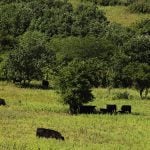Western Canadian feeder cattle prices were steady to $3 per hundredweight (cwt) higher on average last week. Volumes are starting to increase at most auction barns now that the yearling run is well underway.
Labour Day demand and a weak Canadian dollar caused Alberta fed steers to reach a high of $107/cwt, up $3-$4/cwt. Strength in the slaughter market led feeder cattle prices higher. A nice group of Angus-based age-verified steers averaging 935 pounds sold for $128 in southern Alberta. Quality yearling steers in the range of 850 to 900 lbs. sold in the range of $126 to $131/cwt.
Read Also

U.S. grains: Soybeans retreat after rally, wheat holds at three-month high
U.S. soybean futures fell on Tuesday, retreating from a 16-month high hit a day earlier, as traders awaited Chinese purchases of U.S. cargoes following last week’s trade truce agreed by the world’s two largest economies.
U.S. feeder cattle prices were mixed last week, with the financial market volatility tempering buying enthusiasm from feedlot operators. Steers averaging 870 lbs. in Oklahoma sold for $127/cwt. The U.S. Department of Agriculture lowered fourth-quarter beef production estimates, which underpinned the fed and feeder cattle markets late in the week. April live cattle futures finished the week at $127.75, nearing all-time record highs.
USDA estimated the average corn yield at 153 bushels per acre, resulting in a crop size of 12.9 billion bushels, compared to 12.4 billion bushels in 2010. Despite the larger crop, total supplies will be down from year-ago levels due to the lower carry-in stocks.
Cattle producers can factor in another year of historically high feedgrain costs.
The 2011 U.S. cow slaughter will likely exceed 2010, resulting in a further contraction of the U.S. cattle herd. I’ve had a few inquiries from western Canadian cow-calf producers in regards to holding back heifers and purchasing bred cows. Lower calf crops, lower feedlot placements and smaller beef production will be the constant theme throughout 2012. It’s hard to expand the herd given the current price levels; however, in most cases, the hard decision is the right decision.
— Jerry Klassen is a commodity market analyst in Winnipeg and maintains an interest in the family feedlot in southern Alberta. He writes an in-depth biweekly commentary, Canadian Feedlot and Cattle Market Analysis, for feedlot operators in Canada. He can be reached by email at [email protected] or at 204-287-8268 for questions or comments.












